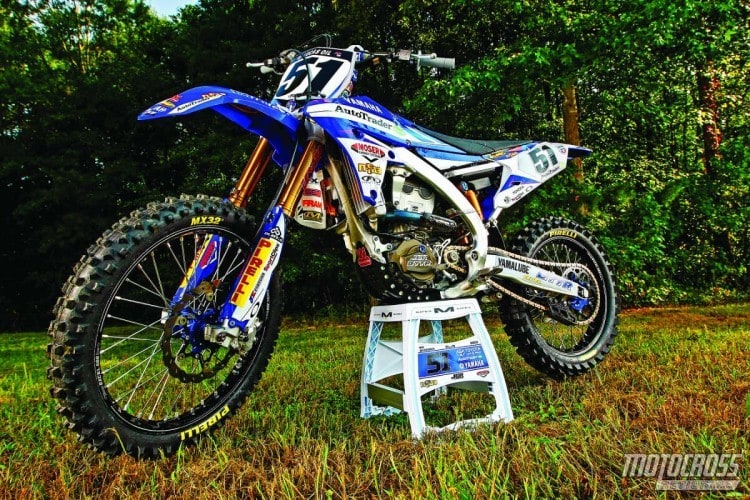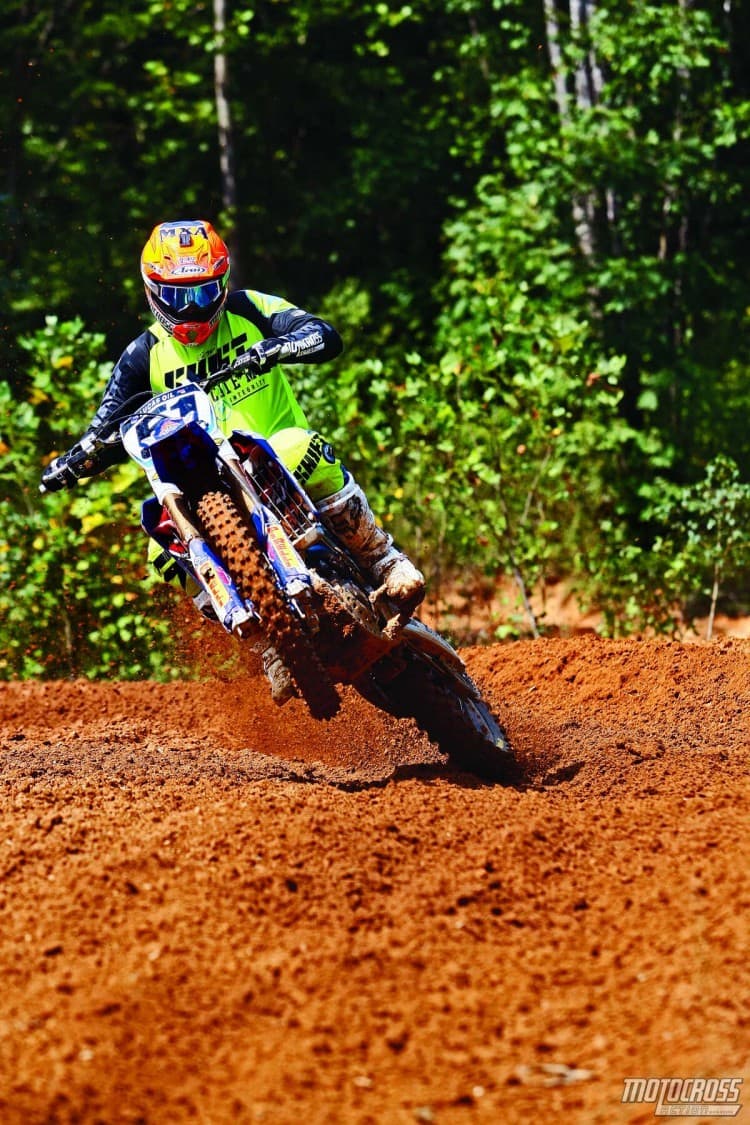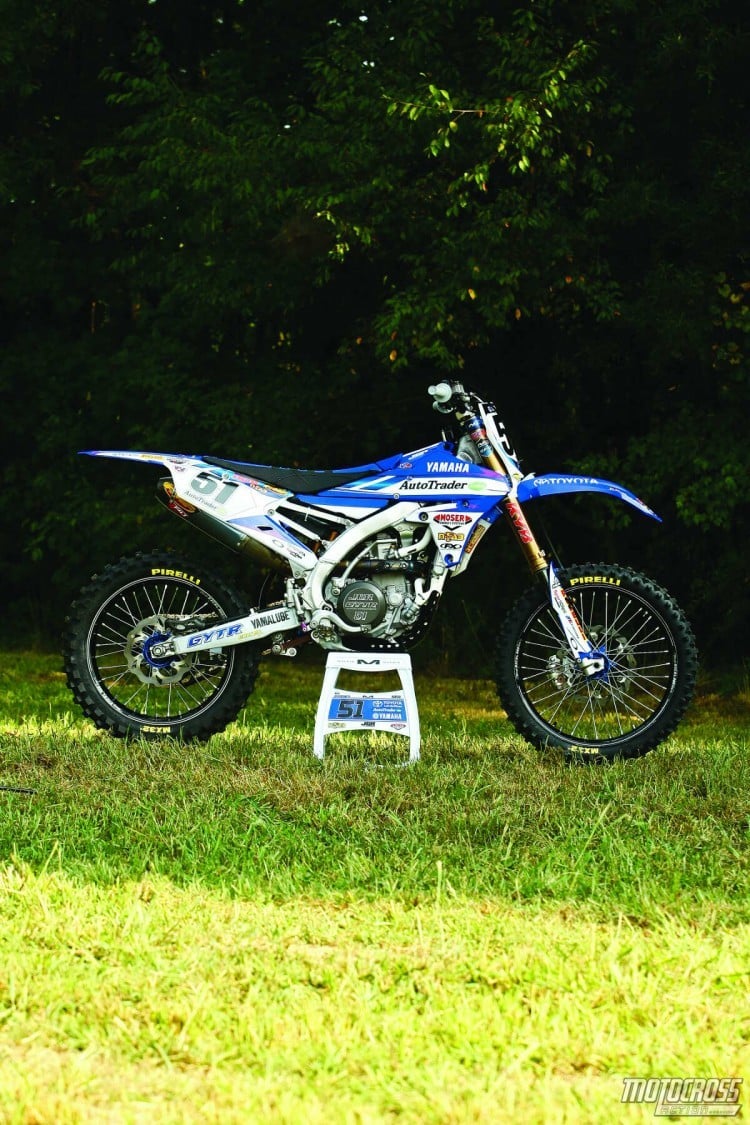WE RIDE JUSTIN BARCIA’S JGR YAMAHA YZ450F
The silly season—the post-season period when riders and teams negotiate contracts for the following year—is an interesting time in the motocross industry. A rider’s value will rise or fall based on his results. Salaries are based on the rider’s valuation—his ability to return on investment. After the 2014 season, Ken Roczen and Justin Barcia hit the open market. Both were proven winners and popular with fans—a win-win for any team with deep pockets and high aspirations. Of course, everyone knows where Roczen and Barcia signed—Kenny with RCH Suzuki and Justin with JGR Yamaha. Which team earned the most bang for its buck in 2015? The results show that Suzuki fared better, despite both riders succumbing to injury during the Supercross series; however, in light of Roczen’s apparent struggles gelling with the RCH Suzuki staff and Barcia getting along famously well with the JGR crew, it would appear that Joe Gibbs Racing is happier in their choice.
Time will tell if the “Bam Bam” and JGR combination will pay off, but if you just use the 2015 National series is as indicator, both parties were more than satisfied. Why? Justin Barcia holeshot 11 motos, won two Nationals and finished third in the overall standings. He was one of only two riders (the other being Eli Tomac) to catch and pass Ryan Dungey outdoors. JGR was so impressed by Justin’s outdoor performances that they drew up a new contract that will keep Barcia under the JGR tent through 2018. Such a long-term commitment shows steadfast faith in a rider. And even though Justin is out of the 2016 Supercross season already with a thumb injury—it’s still worth looking at his bike.
The MXA wrecking crew could sense that Joe Gibbs Racing would let us test Justin Barcia’s Yamaha YZ450F. We were correct. Team manager Jeremy Albrecht gave us carte blanche. On the appointed day Justin Barcia even came along to ride with us, giving insight about his bike and yelling at our test riders whenever they blew out the berms. Below is a list of questions that you’d probably like to ask about Justin Barcia’s YZ450F, along with the answers.
WHAT’S THE TRICKEST PART ON BARCIA’S BIKE? That question was posed to JGR’s Jeremy Albrecht. He wanted clarification, because Barcia’s Yamaha YZ450F has a variety of trick parts, not just for JGR, but specifically for Justin. Albrecht pointed out the works Nissin front brake caliper, which comes directly from Japan. JGR hadn’t used the Nissin caliper before the 2015 season, but Justin Barcia requested the $2100 part when he signed on the dotted line. Why? The factory Honda team uses the billet-aluminum front brake caliper, and Barcia had become accustomed to its stopping performance during his tenure at Honda. JGR bit the bullet and ordered six calipers. Truth be told, Barcia is the only rider on the team to run the works part. Weston Peick and Phil Nicoletti prefer the feel of the 2007 Yamaha YZ450F caliper, which is commonly used by Yamaha race teams. The works Nissin front brake caliper was mated with a Galfer steel-braided line and Galfer 280mm floating rotor.
WHAT’S THE MOST UNIQUE PART ON BARCIA’S BIKE? Choosing one part would do an injustice to the team. The JGR motocross shop is conveniently located next to its NASCAR race shop. The motocross team has open access to all of the NASCAR team’s advanced tooling machines and the latest computer-aided design software. JGR’s engineering whiz, Spencer Bloomer, drew up plans for JGR’s footpegs, shifter tips, adjustable subframes, pull rods, rear brake pedal tips, skid plates and footpeg shields using CAD-CAM software. Did we mention that Bloomer also spins wrenches for Phil Nicoletti and maintains JGR’s many tracks? To work for JGR requires wearing many different hats. In no particular order is a list of the most unique parts on Justin Barcia’s YZ450F.
(1) Footpegs. JGR invested thousands of dollars developing its very own footpegs. Similar in appearance to factory Honda pegs, the JGR pegs allow the team to mount the footpegs in different locations. Barcia likes his JGR titanium footpegs located 5mm back from the standard position. Weston Peick and Phil Nicoletti both prefer their pegs 3mm lower and 5mm back.
(2) Shifter tip. The shifter arm is a stock part, while the shifter tip is considerably longer and aggressively knurled for easier shifting. We should point out that JGR uses a GYTR billet ignition cover. Narrower than the stock cover, it leaves a 1-inch gap where rocks can get stuck between the cover and shifter arm. JGR bends the shift arm in a press so that it sits closer to the engine.
(3) Rear brake pedal tip. JGR ditched the stock aluminum rear brake pedal tip, which can get bent in a crash, for a titanium tip. It is slightly larger and has sharper teeth for a more tactile feel.
(4) Shock link. JGR sells an adjustable pull rod that is very effective at changing the rising rate. Barcia’s bike comes with the adjustable link, but also incorporates a rear shock hold-down clamp. It locks the shock down to keep the rear end tracking off the starting line and comes unclasped once the shock is compressed. The holeshot link was proven successful, evidenced by Barcia’s 11 holeshots during the 450 National series.

This bike is fast. All the more surprising because JGR said that they focused on smoothness over brute force.
WHAT DOES JUSTIN BARCIA LIKE IN TERMS OF BIKE SETUP? Truth be told, neither Barcia nor JGR knew what the two-time 250 East Supercross Champion needed when he came to the team. It didn’t take Sherlock Holmes to deduce that Barcia was uncomfortable on the YZ450F at first. To quote Jeremy Albrecht, “We thought we knew what he wanted. All he wanted to do in the beginning was make the bike slower. It wasn’t the right direction, but we didn’t know it at the time, so we went down that road. At Anaheim 2 we raced with the stock cylinder head. It wasn’t the best setting, but he rode it well. Naturally, he didn’t get a good start at that race. A smoother engine with more power is what he needed. When you’re not winning, you tend to go in circles trying to find the magic setting. Unfortunately, he didn’t know us that well and we didn’t know him, either. We followed him in the direction that he wanted to go until he agreed to let us help.” JGR and Barcia stuck it out, and things worked out in the end.
What does Barcia like in bike setup? Justin prefers the YZ450F powerband to be really smooth and easy to ride. He’s very picky about the front brake and front-end traction. At the beginning of the 2015 season Justin didn’t feel comfortable pushing the envelope, because the front-end felt vague; however, he turned a corner (no pun intended) before the Nationals. Suspension played a big part in overall improvement, as did a switch to 25mm offset triple clamps and the 2016 motor mounts. JGR also added gussets to the frame.

Justin uses NK SFS air-suspended triple clamps. They offer 10mm of movement at the bar mounts.
WHAT JGR-SPECIFIC PARTS ARE ON BARCIA’S BIKE? The team distinguishes its home-grown parts by anodizing them purple. It’s not our favorite color, but the parts stand out. JGR made the footpegs, adjustable subframe, adjustable pull rod with built-in holeshot device, titanium rear brake pedal tip, shifter tip and carbon skid plate. You’ll be pleased to hear that JGR’s retail shop sells many of the aforementioned parts, including many more that don’t come on Barcia’s bike.
WHAT CAN BE FOUND INSIDE BARCIA’S ENGINE? That’s the million-dollar question. Race teams keep the details of their engine program close to their chests, and rightfully so. Horsepower is the name of the game. Judging by the fact that Barcia holeshot nearly half of the 450 National motos this summer, JGR has sliced through the Gordian knot. While we pressed Jeremy Albrecht for answers, he wouldn’t budge on the compression ratio, cam timing, cylinder porting, cam degree or any other pertinent details. Albrecht simply said, “At our level, every little bit counts. We do way more to the engine than many people would ever need done. We use different valves, buckets and cams and a different rod, piston, piston pin and cylinder head. Every piece in the engine is touched.” JGR uses a chemical process called “rimming” to strengthen the engine internals and reduce friction. This is especially important in the transmission.
HOW FAST IS BARCIA’S YAMAHA YZ450F? It’s deceptively fast. We expected greatness out of the engine, given the horsepower numbers reached on a production YZ450F. Our test riders found it hard to believe that Justin Barcia, all of 155 pounds soaking wet, could contain the hurricane-like force delivered by the highfalutin JGR-modified YZ450F engine. The power wasn’t overwhelming when cracking the throttle around a few corners, but we became more respectful of Barcia’s bike as the laps clicked off. How Justin hangs on to the bike for a whole moto is beyond comprehension. Maybe there’s a reason why, more often than not, Barcia carries the front end high when exiting corners from Hangtown to Crawfordsville. The JGR-massaged engine puts power to the ground with authority, although bottom-end hit seemed subdued compared to the stock YZ450F engine’s delivery.

The right side of Justin’s YZ450F houses the throttle, two-way map switch and red launch control button.
WHAT IS BARCIA’S SUSPENSION LIKE? First, a note on JGR’s suspension philosophy. MXA tested Justin Brayton’s 2010 JGR YZ450F, which had an amalgamation of suspension components the team used to create its vision of the ultimate package. The Showa forks, known by the team as “F-Type,” and “Version 2.0” shock were built in-house by tuner Johnny Oler and are unavailable to anyone outside of JGR’s top riders. The unconventional approach didn’t pan out. Yamaha’s suspension technicians were unable to provide support, because they weren’t familiar with what JGR was using. Conversely, JGR wasn’t helping Yamaha develop new suspension technology. The JGR components were scrapped in favor of works Kayaba suspension.
Justin Barcia’s suspension was stiff, but that shouldn’t surprise anyone. We have yet to test the bike of a top-tier Pro and find the suspension suitable for a slow rider. It just won’t happen, because the speed with which Justin Barcia hits bumps requires stiff valving and larger internals to flow oil more effectively. So, instead, the MXA wrecking crew measures the performance of a Pro racer’s suspension based on the amount of fork travel. Barcia’s KYB air forks gave no quarter in the initial part of the stroke. We had to slam hard into braking bumps in order for the travel to break through the crust. Once it did, the forks became really progressive and absorbed impacts well. Getting to that point was not possible for slower riders, but our Pro-level testers appreciated the payoff, especially when overjumping landings. The KYB shock was considerably softer than the forks and was well-liked by our range of testers. A stiff front end matched with a soft shock is a common setup for most AMA Pro riders.
WHAT OTHER PARTS ARE FOUND ON BARCIA’S BIKE? We can’t forget to mention the FMF Racing Factory 4.1 exhaust; GYTR sprockets (with 13/48 gearing), clutch, camshafts, cylinder head and ignition cover; Excel A60 rims with Kite hubs from Dubya (the spokes are works Yamaha); Kite holeshot device; Neken air triple clamps (Barcia ran 70 psi); Xceldyne valve train and titanium valves; Galfer brakes and front brake line; Renthal 996-bend TwinWall handlebars and full-diamond soft-compound grips; titanium bolts built specifically for JGR by Race Tech; Think Technologies light seat foam; Factory Effex graphics; Cycra Powerflow plastics kit; Pirelli tires and mousse inserts (front and rear); CV4 radiator hoses; ARC clutch perch; and the aforementioned GET ignition system.
WHAT DO WE REALLY THINK? There’s a reason Justin and JGR extended their partnership through the 2018 Nationals. Good vibes flowed at last year’s outdoor series, and the rough start turned to smooth sailing. It’s foreseeable that Barcia and JGR will continue on a path to success with the ultimate goal of winning a title. Barcia has the platform to win. JGR has unlimited resources and Justin has an irrepressible go-for-broke style. Can the combination dethrone Ryan Dungey in the 2016 Nationals—now that his chance of doing it in Supercross is gone? You’d be smart not to bet against a healthy Bam Bam and his JGR machine.










Comments are closed.